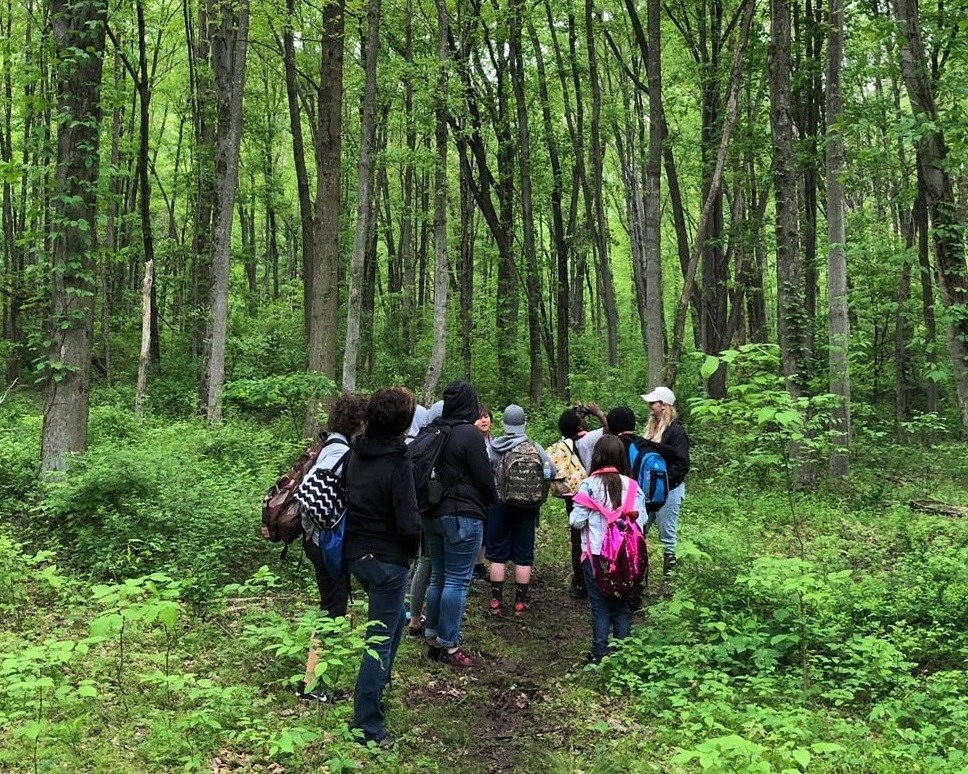How Being an Environmental Educator Made Me a Better Scientist
Posted on in In the Field by Shannon Lambert, Spring 2019 Education Trainee

Despite only spending 3 short months at Hawk Mountain Sanctuary, it had an enormous impact on my life and career. I was an education trainee during Spring 2019, where I learned all about how to disseminate information to the public in a way to get them excited about the environment. My responsibilities focused on Wee Ones, Homeschool Happenings, and local school trips, so I dealt mostly with kids. Since I had to explain the foundational reasons for why conservation is so important during my presentations, my experience on the mountain inadvertently reinforced my values for conservation and the importance of natural resources.
The principles of the North American Model for Wildlife Conservation’s underlying philosophy is that wildlife resources are our shared right. Leading trips, presenting cool information and exposing people to nature really reinforced how important this idea is. Seeing kids and adults alike light up when I brought out a live bird or watching them get lost in the experience of a guided hike demonstrated the importance of access to nature. Our natural resources are ours to enrich our lives, and I want my work to always be in pursuit of this.

I had to cut my time at Hawk Mountain short, because I was accepted into graduate school in Colorado to study elk, and I needed to be there by early summer to start collecting my data. My master’s thesis focuses on elk recruitment: how many calves survive into adulthood and become a part of the population. The calves on the Uncompahgre Plateau have incredibly high mortality rates, but the biologists cannot determine the cause. Two-thirds of calves conceived in that region don’t even make it through their first 6 months of life, let alone through their first winter when survival is notoriously difficult. My goal is to identify the most important sources of mortality so that biologists can take steps to increase calf survival and stabilize the elk population.
Before I came to Hawk Mountain, I knew public outreach was an important part of conservation, and I knew I enjoyed teaching based on my experiences with tutoring, but I never would have guessed I would fall head over heels in love with public outreach and education like I have. Ever since I had to leave for school, I have been searching high and low for opportunities to work with the public again. Last semester, I was able to participate as an ‘Expert Judge’ for a local high school’s problem-based learning project focused on urban black bear mitigation (a common issue throughout Colorado). I had the privilege to watch dozens of student presentations discussing the state of bear conflicts and ideas for how to solve the issue. My job was to ask the students questions to encourage critical thinking and to provide feedback to better strengthen their arguments.
This semester, I will have a table at a high school’s “Earth Day Expo”, where local conservation professionals will give short presentations on the importance of conservation and how their work supports the cause. Since my research focuses on elk populations, I am going to present on trophic cascades, keystone species, and the importance of keeping the ecosystem in balance. The event isn’t for another two months, but I’m so excited that I’ve already drawn up a lesson plan, designed an activity, and found supplemental materials that students can take home for further learning. This will be extra fun because I’m testing out the exercise on my fellow graduate students!

Being able to marry wildlife research with environmental education has a special effect on me as the presenter. The prompt for this coming event in particular has caused me to sit down and really reflect on the big picture questions. Why am I researching this? What good will come of my results? The knee-jerk reaction is that more elk = more hunting opportunities—which is a good reason in and of itself—but this project is so much larger than that. The entire elk herd could be depleted in just a few short years if recruitment rates do not improve. Elk have been proven time and again to have a huge impact on the ecosystem. An overabundance, such as documented in Yellowstone, can be detrimental: out-competing other herbivores, killing off entire generations of trees, and increasing erosion along the rivers. But in cases with healthy levels of elk, such as in my study area, a loss of elk can be just as detrimental: decreasing forage quality and availability, shifting chemical composition of the soil, and decreasing large predator populations that depend on elk as food.
This whole story just to say my training in environmental education has taught me not only how to encourage others to get out and enjoy the bounty of nature we have, but has also reminded me of my own values and fostered my critical thinking to create projects that further them. Ironically by teaching others, I have taught myself some important lessons too, and for that I am grateful to my time at Hawk Mountain Sanctuary. Without my traineeship, I doubt I would be thinking about my research in the big picture as it pertains to both people and the ecosystem.